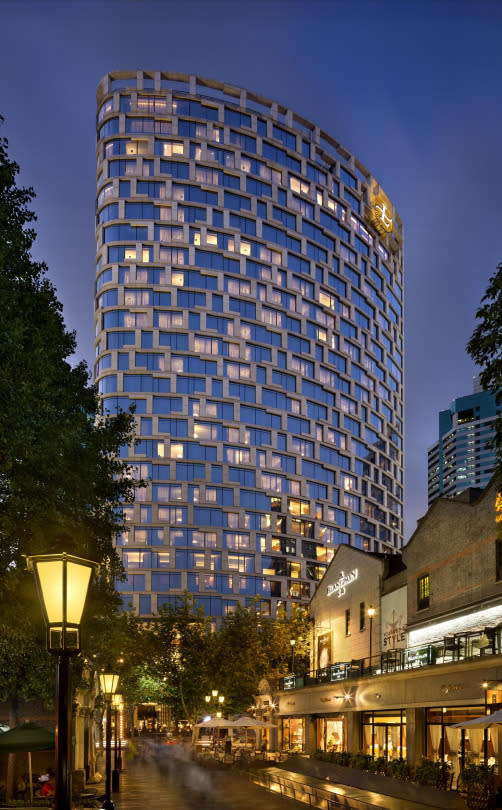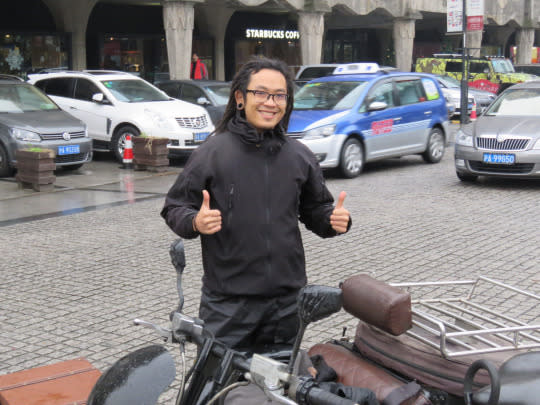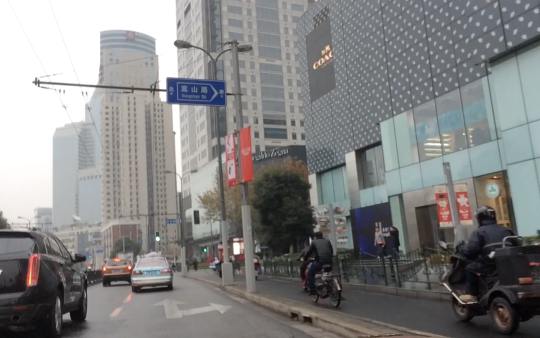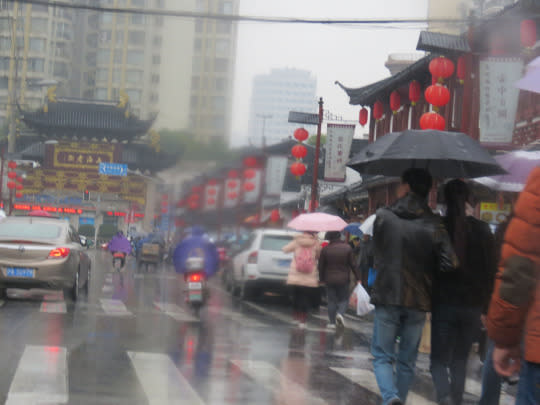The Coolest Way to See the Real Shanghai: By Sidecar
The good news: I had a chance to see Shanghai, China — a city I’d always wanted to visit.
The bad news: I only had 45 hours to spend there (plus an additional 24 hours flying there and back). Despite that limited amount of time, I decided to take the trip. I figured it’d be a fun challenge to see as much as I could of China’s largest city in as little time as possible.
Problem was, once I touched down in Shanghai, I went a little hotel crazy at The Langham, Shanghai, Xintiandi. Like in Skyfall — when James Bond visited Shanghai and killed time before his mission in his hotel swimming, hanging out at the bar, and practicing his “Bond, James Bond” scowl — I frittered away a good portion of my Shanghai time tossing back cocktails in the Langham’s martini bar, taking in the spa, and hanging in its upstairs club lounge.

My base of operations for my Shanghai mission: The Langham, Shanghai, Xintiandi (Photo: Langham)
I lounged around probably a lot more than Bond did. But unlike him, I didn’t have any pressing assassinations to get to, so it was all good.
My hotel adventure was fun, but after a good 12 hours of luxuriating, I still hadn’t gotten out to see much of the city. If I wanted to be able to swap Shanghai stories with some of my friends — who fly back and forth to China on business with the same ease that I trudge across the street for my writer’s block bagel — I needed to get my Shanghai on, pronto!
Related: How to Tip in Asia: When, Who, and How Much
Fortunately, the folks at the Langham fixed me up with one of the more popular and efficient ways to see Shanghai: a motorcycle sidecar tour.
So on a gray, chilly, and rainy afternoon, I met up in the hotel lobby with Gary, the Shanghai-born and bred motorcyclist whose sidecar I’d be occupying for my three-hour tour. It was one of those days where my firsts were piling up: my first trip to Shanghai, my first time on (or, more accurately, attached to) a moving motorcycle. And, in meeting Gary, the first time I’d ever seen a Chinese guy with dreadlocks.

Gary and his dreadlocks whisked me around Shanghai. (Photo: Sid Lipsey)
At our first meeting, it was clear Gary’s friendly, easy-laughing manner would match quite nicely with my slightly nervous, fish-out-of-water vibe during this international adventure. I’m hoping Hollywood will call us to do a reboot of the Rush Hour movies.
The Chinese-made sidecar in which I’d be riding was a classic-but-nondescript affair whose most interesting feature was the mysterious briefcase Gary had affixed to its front. I managed to curb my natural journalistic curiosity to ask what was in it. For the meantime, I pretended it contained some top secret file Gary and I would be delivering during our Shanghai adventure. Man, this was getting more James Bond-like by the minute!

Gary and I get ready to get our Shanghai on. This is the picture I’m sending to Hollywood to get us in that Rush Hour movie reboot. (Photo: Sid Lipsey)
After strapping on our helmets, we got the motor runnin’ and headed out on the rain-soaked streets of Shanghai. The Langham is in the Xintiandi district, which is teaming with high-end stores, international hotels, and expensive boutiques, so Gary and I spent the first part of our trip motoring through there and the French Concession. There was a steady drizzle at this point, but I didn’t care; I was ecstatic to be zipping on a motorbike through a new city. Now I knew what all those bikers were talking about when they romanticized life on the open road.
“How do you say, ‘Born to be Wild’ in Mandarin?” I asked Gary. He smiled and kept driving. Guess it doesn’t translate.

Gary couldn’t get us out of the high-rise-heavy touristy area fast enough. He was determined to show me what he calls “The Real Shanghai.” (Photo: Sid Lipsey)
Though he was stumped at that question, Gary was very talkative during our tour. “A couple of years ago, I was a motorcycle racer,” he told me at our first red light. But then he got married and his wife, fearing the danger, made him quit.
“I’m a local Shanghainese boy,” he explained. “So wife is boss.” We laughed. Two married guys — one a Chinese motorcycle enthusiast with dreads, the other an American tourist with an ill-fitting helmet — sharing a knowing chuckle at a universal truth.

What’s in this briefcase? I spent about 10 miles wondering. (Photo: Sid Lipsey)
After weaving in and around the British Concession, we entered Shanghai’s Old City. Gary all but breathed a sigh of relief to be away from the Starbucks and Zegna stores that inundate the neighborhood we’d just explored.
“I don’t like tourist areas,” he told me. “You see all the same things. Too many people.”

We roll up to the Shanghai Postal Museum. (Photo: Sid Lipsey)
Gary is well aware of the bright, neon-colored big-city image Shanghai has cultivated in recent years. “ In most of the tourists’ minds, Shanghai is a financial center — a modern city,” he said. “This is not the real Shanghai. I just want to show some tourists the real Shanghai.”
Related: I’m Black, So I’m Kind of a Big Deal in China
And show me he did. The gleaming, modern hotels and office buildings soon gave way to the slightly dingy, pre-World War II structures. When we got to the Hongkou district, Gary parked and got off the bike. To my delight, he went for the briefcase at the front of the sidecar. Finally, the big reveal: he popped open the briefcase and pulled out a small metal thermos and a single teacup. The cup was for me.
“It’s hot wine,” he told me. Another first for me — I didn’t know there was such a thing as hot wine. Well, wine is always good, and hot anything on this cold and rainy day was welcome. Because he was driving, Gary didn’t partake. But as far as I knew, there were no laws in Shanghai against drinking and riding, so I killed the thermos myself (which, unlike Bond in Skyfall, was the only thing I killed in Shanghai).

Hot wine? Don’t mind if I do… (Photo: Sid Lipsey)
After the hot wine break, we stepped inside a nearby landmark called “1933.” It’s a massive, concrete structure originally designed (guess the year) as an urban slaughterhouse.

The old slaughterhouse, “1933.” (Photo: Sid Lipsey)
“This used to be the biggest slaughterhouse in Asia,” Gary informed me. Now it’s a collection of bars, restaurants and stores. Still, the slaughterhouse backdrop remains — the concrete-heavy complex is laid out in a maze-like format with ramps that have ridges on the floor. The ridges, Gary explained to me, were another holdover from the slaughterhouse days; they were there to direct cattle to head upstairs to the massive slaughter area. Any livestock that tried to reverse course and head back down would fall. “The cattle did not come back down,” Gary said ominously.

The former slaughterhouse now houses shops and restaurants. (Photo: Sid Lipsey)
As we toured the trendy spaces that now occupy the building, Gary filled me in on its gory history. When we reached the top level, Gary said: “They killed animals here. The middle used to be a pump. They pumped water upstairs to clean the floor of the blood.” It was enough to make me resolve to be a vegan — a resolution that, sadly, lasted until dim sum back at the Langham after the tour.
Related: Could Shanghai’s Disneyland Be Cooler Than Walt Disney World?

1933′s top floor recently has paid host to another kind of cattle call: fashion shows. (Photo: Sid Lipsey)
After the visit to 1933, it was time to see more of Shanghai. As the rain started coming down even harder, we zipped through Old Street to gaze at its traditional Chinese architecture.

Tooling down Old Street. (Photo: Sid Lipsey)
Then we returned to the 21st century as we zipped along the Bund, the tourist-heavy waterfront that faces the skyscrapers across the river. Pointing across the river as we motored along the Bund, Gary said: “20 years ago, the Pudong side over the river [was] nothing. Just farmland.” Now it consists of the skyscrapers that make up Shanghai’s famous skyline.
Related: Take a Walking Tour With Former Gang Members in Panama

The Oriental Pearl Tower looms across the river as Gary and I motor along the Bund. (Photo: Sid Lipsey)
"Just in 20 years Shanghai developed very fast,” Gary said, lamenting all the old homes and buildings razed in favor of the trappings of the new Shanghai. “We lost a lot of historical construction. Somehow we lost our culture.”
I nodded in agreement and recognition. Like our previous laugh about husbands who give up dangerous activities at the requests of their more-sensible wives, the sacrificing of history for economic progress is another cultural experience Gary and I both share.
We made our way back to the shops and eateries of the French Concession and ended our tour of Shanghai. I saw areas I’d want to check out more thoroughly next time I’m in Shanghai (if I want to continue enjoying cheeseburgers, I probably shouldn’t return to 1933). But I felt I got a nice Shanghai sampler during my brief stay. So now I can say I know the city should the James Bond or Rush Hour people ever decide to give me a call.
Seriously, Hollywood: Me. Gary. Motorcycles. Rush Hour movie reboot. Comedy gold!
WATCH: Going Full Local in Puerto Rico
Let Yahoo Travel inspire you every day. Hang out with us on Facebook, Twitter, Instagram, and Pinterest.
